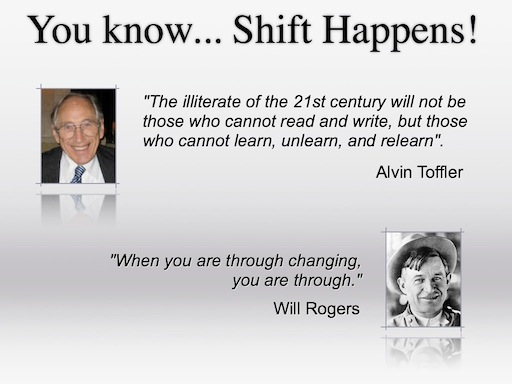In 2007 I was making a joint presentation with a colleague from the USA. She introduced the concept of a continuum along which a teacher can move based on how he/she teaches. We called it the Continuum of Shift.*
This concept has been a great help to me as a support person, helping teaching faculty in higher education. How easily a teacher can move their pedagogy along this continuum I’m sure is what makes a great teacher in higher education for the 21st century.
I think it is unhelpful and actually slows down change, when elearning experts suggest how academics have taught in the past is wrong and imply we now have a better way.
The job of the Learning Designer is to help teachers know when and how to move their pedagogy along this continuum. They need to know when, where and how to move along between:
- A Content Centred Paradigm and an Activity Centred Paradigm
At the content end of the continuum the teaching is instructor centred, behavourist and intructivist in nature, while at the activity end it is constructivist in nature, focusing on context and the learner experience is at its core. - An Activity Centred Backgound and a Content Centred Background
The content end of the continuum has a detached approach; it focuses on memorization and teaching what the instructor deems necessary to know. At the activity end, it focuses on a situated approach to the learning framed by what learners must do to achieve an outcome. Learning is achieved by active engagement in meaningful and authentic activities that require learners to build versions of their learning. - An Activity Centred Assessment and a Content Centred Assessment
Assessment at the activity end of the continuum can include projects, portfolios and peer or self-evaluation, which can address deep learning. At the content centred end learning assessment usually measures surface learning with typically right or wrong application or multiple choice examination
How can you as an Academic move easily along the continuum and manage change? When you are shifting between content centred and activity centred you need to accommodate a variety of delivery modes. They could be synchronous, asynchronous or blended. Teaching needs to address the learner’s needs, it should consider the learning styles and information literacy capabilities of the students and activity learning sequences need to show they are “goodfers”. i.e. the learner understands what the learning outcomes are good for in real life?
As I have worked with the Continuum of Shift over the last 5 years I have pondered the questions. How can I help an academic:
- Easily focus on activity centred learning
- Increase student engagement
- Deliver content more efficiently and student centred
- Turn valuable face-to-face time into deeper learning experiences.
I believe I have found a way … it is called LAMS!
* Adapted from teaching by Professor Cindy Russell, The University of Tennessee Memphis USA in an eLearning Guild presentation Aug 2007


Pingback: Allan's Blog